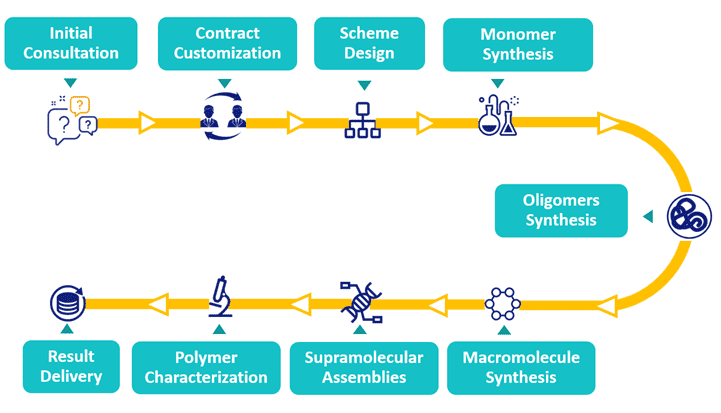Cysteine-polymer Conjugation Technologies
As a highly specialized polymer modification service provider, BOC Sciences provides the most complete peptide-polymer conjugate solutions for the pharmaceutical and materials industries. Our scientists focus on the custom development of pendant peptide- and linear peptide-polymer conjugates. We provide hierarchical self-assembly over multiple length scales down to the molecular level, chemical functionality, selectivity and specificity, and dynamic responses to external stimuli, all properties of interest to the materials community.
Introduction of Cysteine-polymer Conjugates
Cysteine residues are valuable targets for residue-specific modification of peptides/proteins in that these residues are relatively rare, having a natural abundance of 1.5%. Cysteine residues are often found partially of fully buried within the protein structure, a property which may limit their accessibility to chemical reagents. However, under appropriate conditions, cysteine can be modified selectively, rapidly, quantitatively and in either a reversible or irreversible fashion. An easier way to create well-defined polypeptide-polymer bioconjugates is to target a more specific functionality within the peptide or protein. In polypeptides there are only a few cysteines that do not participate in disulfide bonds. This low natural abundance makes it easier to functionalize proteins via the available cysteines at a specific location and thus minimize loss of biological activity. As an additional advantage, the overall charge of the polypeptide is maintained. In the absence of a free and accessible cysteine in the native structure, one can be added by site-directed mutagenesis or by introducing a cysteine-containing peptide connector in a fusion-protein.
 Fig. 1. Example of peptide-polymer conjugates (Carbohydrate Polymers. 2022, 280 (15): 119025).
Fig. 1. Example of peptide-polymer conjugates (Carbohydrate Polymers. 2022, 280 (15): 119025).
Our Cysteine-polymer Conjugation Services
Cysteine-polymer Conjugation by Thioether Bond
One of the cysteine reactive reagents that reacts with thiols via a Michael addition is the alkylating agent vinyl sulfone. Because of the soft nature of this electrophile, it is quite selective to thiols, even in the presence of other hard nucleophiles such as amines and hydroxyl groups. However, the vinyl sulfone group only reacts slowly with thiols. The reaction is accelerated by increasing the pH, but this will also give more side reactions with lysines. The charge environment of the cysteine can furthermore also have an effect on the ease of the reaction. In one example of this strategy, chloroethyl sulfone was first introduced to a PEG chain by a four-step procedure, and then converted to vinyl sulfone in the presence of base. This gave the possibility to selectively attach the PEG derivative to the cysteine residues of reduced ribonuclease. Cysteine on polypeptides can self-assemble with polymers via thioether to form well-defined superstructures. Using these properties by BOC Sciences provides additional opportunities to control polymer-peptide self-assembly to generate unique structures and materials for biomedical applications.
Cysteine-polymer Conjugation by Disulfide Bond
Another strategy for the conjugation to cysteines involves the formation of disulfide bonds. To this end, the thiol group of the cysteine residue on the peptide is reacted with an activated disulfide group on a polymer. A thiol disulfide exchange subsequently forms a new disulfide bond connecting the peptide with the polymer. An advantage of this strategy is that the activated disulfide group reacts specifically with thiols under a broad pH range (pH 3-10). The disulfide bond formation is completely reversible and can be reduced using standard reducing agents like dithiothreitol (DTT). Self-assembling peptide-polymer conjugates have drawn considerable research interest and intensively explored for applications in tissue regeneration, catalysis, and drug delivery. With years of experience in polymer development and synthesis, BOC Sciences will screen and design the most suitable peptide-polymer conjugates strategies based on the type, length and steric hindrance of the polymer molecular.
Our Polymer Bioconjugation Workflow

References
- Klok, H.A. et al. Peptide/protein-polymer conjugates: synthetic strategies and design concepts. Chem. Commun. 2008, 2591-2611.
- Hest, J. et al. Polypeptide-polymer bioconjugates. Chem. Soc. Rev. 2010, 39: 329-353.

 Fig. 1. Example of peptide-polymer conjugates (Carbohydrate Polymers. 2022, 280 (15): 119025).
Fig. 1. Example of peptide-polymer conjugates (Carbohydrate Polymers. 2022, 280 (15): 119025). 






